Baked Sweet Potato with Cashew Cream

Sweet potatoes are one of my favourite foods. Straight from the oven – deliciously sweet and sticky I love to fill them with some quinoa, vegetables and a creamy sauce. These nutrient dense packed potatoes make a fantastic lunch or dinner. They are hugely filling and will keep your blood sugar happy all day.
Orange-fleshed sweet potatoes may be one of nature’s unsurpassed sources of beta-carotene. Several recent studies have shown the superior ability of sweet potatoes to raise our blood levels of vitamin A. This benefit may be particularly true for children. This recipe and many others from my ‘Power Packed Lunches’ cooking classes are easy to prepare the night before, pop in a container and take to the office with you.
2 large sweet potatoes
1 cup quinoa
1 1/3 cups filtered water
Pinch sea salt
1 clove garlic crushed
1 onion finely sliced
8 or 10 fresh shitake mushrooms, thinly sliced
Shoyu or Tamari
Flaked almonds for garnish
Finely sliced spring onions for garnish
Preheat the oven to 220/440°. Scrub the potatoes and pierce with a sharp knife or fork. Place on a parchment lined baking tray in the middle of the oven for approximately one hour or until the potatoes are soft. Meanwhile rinse the quinoa and place in a heavy based pot. Add the water and bring to a slow simmer. Reduce the heat to low and cook for 15 minutes until quinoa is fluffy and all water has been absorbed. Leave covered for another 15 minutes. Remove to a bowl and fluff up with a fork.
Heat a splash of water over a low heat and add the garlic, onion and a pinch of sea salt. Sauté for 5 minutes or until the onion is soft and slightly browning. Stir in the mushrooms add a splash or two of shoyu and a little water if the pan seems too dry. Cover and cook on a low heat for 5-7 minutes. Remove from the heat and set aside.
Cashew Cream
1 cup cashews
2 cups filtered water
1 Tablespoon apple cider vinegar
2 Tablespoons fresh lemon juice
1 heaped tbsp sweet white miso
1 heaped tbsp light tahini
Sea salt, to taste
1/4 tsp. ground nutmeg (optional)
In a blender combine the ingredients and add the water a little at a time until you reach the desired consistency of a heavy cream. For a thinner (sauce) to add to other dishes, simply add more water. Cut open the potatoe, spoon some quinoa into the centre, top with the vegetable filling and cashew cream and garnish with toasted flake almonds and spring onions. Delicious.
Please note:I only use organic fair-trade ingredients that are kind to the soil, the planet and do not involve food slavery or injury to workers. Please be conscious of where your ingredients come from.
In good health
Magic Mineral Broth For Fat Burning
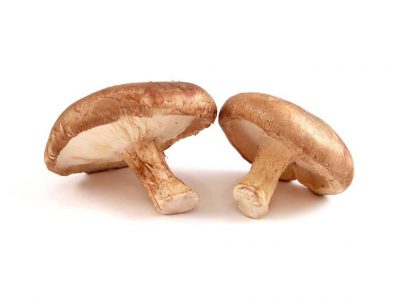
Magic Mineral Broth For Fat Burning
A vegetable broth made from organically grown vegetables can be an excellent source of essential electrolytes. Ionic minerals are the key to maintaining good health. My broth is incredibly nutritious and a health-boosting food that is very easy to make that will assist in you finding your ideal healthy weight. There is no absolutely no need to use the bones of our animal kingdom for the so-called miracle cure all that humans hanker after. My three 'magic' ingredients in my mineral broth come from plants. Kombu seaweed, dried shiitake mushrooms and dried daikon.
This organic magic mineral broth is a wonderfully filling snack that will also provide you with many healing nutrients and alkalinize your system, making it easier to detoxify, lose weight, and feel great.
The recipe can be varied according to taste. I use my magic broth for clients with cancer, diabetes and a host of other illness’s, it’s fantastic for discharging excess fat and proteins that accumulate around our organs and is a wonderful broth for weight loss
Please incorporate this amazing broth into your diet. A healthy equilibrium is the key to strength and vitality. You can make this broth with me in your kitchen by clicking on my video below.
Recipe for Alkalizing Vegetable Mineral Broth:
2 x 5 inch strips of dried Kombu seaweed
6 dried Shiitake mushrooms
1 x 40g pack dried daikon
6 carrots cut into chunks
2 medium onions cut into chunks
1 leek, both white and green parts, cut into chunks
1 small bunch of celery including the heart, cut into chunks
5 unpeeled cloves garlic, halved
1 small pumpkin or squash with skin on, quartered
5 inch piece of fresh ginger, sliced
4 cups chopped greens such as kale, chard,
½ bunch fresh flat-leaf parsley
In a large stock or soup pot, combine all the ingredients. Fill the pot to 2 inches below the rim with water, cover, and bring to a boil. Remove the lid, decrease the heat to a medium/low simmer for a minimum of 2 hours. As the stock simmers, some of the water will evaporate; add more if the vegetables are exposed. Simmer until the full richness of the vegetables can be tasted. Strain the stock and pour into glass storage jars. Refrigerating works well with any broth.
The ingredients above serve a family for days but you require rather a large stock/soup pot so adjust the ingredients accordingly for your own needs. Drink 2 to 3 cups daily in between meals (not with food).
Green Light To Health With Mother Nature's Food

My Food Doesn’t Grow in Dirt! It Comes From a Factory!
This is the reply Bill received from a group of kids when he asked them the question, do you know where your food comes from? Pretty scary answer right? The soil is a living thing, a specific ecosystem comprised of billions of living creatures.
In general, most plants as we all know grow by absorbing nutrients from the soil. Their ability to do this depends on the nature of the soil. Organic farmers of course know the difference between soil and ‘dirt’ but not to put too fine a point on it, the kids didn’t even believe that the food they eat is grown in ‘dirt’.
That was what inspired me to create my ‘Tasty Tips for Kids’ Workshops in many countries. The first thing I do to is have my young students plant some seeds in some ‘dirt’ and then see the beautiful foods that grow from nature. I then have them washing, slicing and cooking greens, dress the greens with some sweet dressing and sprinkle with some sesame or pumpkin seeds and hey presto, their happy. Many families move forward, changing their diets just by seeing how much their kids enjoyed the session. So my message to you all is to get your hands in some ‘dirt’ and grow some greens and teach all and sundry to do the same. Here is my absolute favourite greens dish of all time. Enjoy the recipe: instructions below.
Energised Greens & Hijiki Saute

Don’t give sickness the green light to establish itself in your body. Use green foods to alkalise and reduce acidity, because even a slight rise in acidity can turn your body into a breeding ground for illnesses and disease.
Chlorophyll is rich in all green foods. Green foods are the closest component to the human body. If there was a perfect food for the body it would be green food. As you know chlorophyll delivers oxygen to the plant so anything green is like having the life blood of the plant. This helps us create healthy vibrant blood cells which then give us vibrant health and a disease free body.

I use bitter greens at least 3 times a day and have done for decades. This food tastes good in salads, stir-fry’s, stews, soups and teas and thankfully you have nature on your side, providing these miracle plants in abundance during each season.
Dark and leafy greens; Here are some great examples; spring greens, kale, broccoli, rocket, watercress, parsley and coriander and a plethora of others are powerhouses of chlorophyll. In addition to being vitamin-rich (like most greens), bitter greens are exceptionally beneficial for digestion. Raw leafy greens are the top of my list, solid green vegetables second, non-green, non-starchy vegetables third and starchy vegetables fourth.
Here are the top health benefits of eating energised bitter greens:
- They’re a nutritional powerhouse
Bitter greens are packed with vitamins A, C and K, and minerals like calcium, potassium and magnesium. Filled with folate and fibre and low in fat and sodium, these greens are a nutritional powerhouse! They promote great skin (beta-carotene), a strong nervous system (folate), healthy blood clotting (vitamin K) and contain phytonutrients shown to support eye health.
- They’re digestive magic.
Eating bitter food activates taste buds that simultaneously stimulate enzyme production and bile flow, which promotes digestion. The better your food is digested, the more nutrients you’ll absorb from your food. It doesn’t matter what you eat, if you can’t absorb it, it won’t be of much benefit to you. The high fibre content in bitter greens also helps to eliminate waste through the digestive tract.
Bitter greens also promote natural detoxification of the liver, which regulates cholesterol, balances hormones, detoxifies the blood, and metabolizes fats. We need to eat more bitter greens to digest fats in a more efficient manner.
- They’ll balance your taste buds and reduce cravings.
Unfortunately, a western diet primarily consists of sweet and salty tastes, and is lacking in others. It is to our benefit to eat foods that activate all of our taste buds and start with incorporating some seriously healthy bitter greens! It’s also been suggested that consuming bitter greens daily may also reduce food cravings and aid in weight loss!
Greens will keep in the refrigerator for 2 to 3 days, but it’s best to use them as soon as possible. To prepare greens for cooking, wash or “bathe” greens in a sink full of water and then remove any hard stems or stalks.
Steaming greens reduces bitterness, enhances digestibility, and even releases nutrients for easy absorption. The more alkalising foods you eat, the less sugar you will crave. Easy! A delicious topping or side dish to greens is my favourite sea vegetable that I use on my ‘Natural Woman’ workshops. Hijiki is an ‘ace’ hormonal balance food.

1 cup hijiki soaked until tender 20 minutes
2 tbsp rice mirin
Filtered water
3 shallots thinly sliced on the bias
1 carrot cut into julienne
Soy sauce (tamari or Shoyu)
Heat a splash or two of water in a pan over medium heat. Add drained hijiki and cook, stirring about 5 minutes. Add the mirin and enough water to half-cover the seaweed and simmer over low heat for 20 minutes. Add shallots and carrot, season lightly with soy sauce, cover and simmer for 10 minutes Remove the cover and allow to cook until any remaining liquid has been absorbed. Transfer to a bowl and serve with toasted sesame seeds.
In good health
Marlene x
Food Enzymes & Health

Other ways to naturally increase your enzyme levels are, increasing your intake of raw, living foods, eat fewer calories, and CHEW your food thoroughly. I have been sprouting for decades and it’s something I urge you all to adapt into your diet. All through winter when your food is always cooked you can add these sprouts to soups, beans, grains, vegetables.
Your immune system begins in your gut and if you have enzyme and digestive issues, chances are your immune system isn’t functioning as well as it should be. Your capacity for enzyme production declines with age so it becomes even more important to have a diet that supports ways to naturally boost our enzymes.
Last weekend my workshop focused on food enzymes and health. The three basic categories of enzymes; digestive, metabolic and food based are equally important. When we have a good supply of digestive enzymes the less burden is placed on our bodies to produce these, so whatever enzymes are not used up in digestion is then available to help with other important physiological processes. Here are a few lovely recipes we made at the workshop for you to enjoy.
Cavolo Nero Side Dish
A loose-leafed cabbage from Tuscany, Italy. The leaves are a very dark green, almost black, hence its name, which translates as ‘black cabbage’. It has a pleasantly tangy, bitter flavour, with a sweet aftertaste. Look for crisp, unblemished leaves, with no holes. Avoid cores that are split or dry. Remove old or damaged outer leaves, cut the leaves free of the core and slice out any tough central stalks. Rinse, then chop or slice. Steam for a few minutes and serve with some fresh sprouts and a splash of reduced balsamic vinegar. Delicious.
White Bean Soup
1 red onion, chopped
1 leek, finely sliced
3 cloves garlic, chopped
2 carrots, chopped
2 sticks celery, sliced
8 to 10 fresh shitake mushrooms, thinly sliced
1 tbsp. chopped fresh rosemary, (plus 4 sprigs)
1 jar organic white beans, (haricot or butter beans)
1 ½ cups vegetable stock
1 tbsp, organic tomato paste
½ cup fresh coriander, chopped
In a soup pot warm a little water, add the onion, leek and garlic and sauté for 5 minutes. Stir in the carrots, celery, mushrooms and chopped rosemary, (the springs are for garnish). Cook for 5 minutes, covered to allow the vegetables to soften slightly, add some water if the pot seems dry and the ingredients are ‘catching’.
Add the jar of white beans plus their juice along with the vegetable stock and the tomato paste. Cover and cook over low heat for 15 – 20 minutes. Stir in the fresh coriander and leave to sit for 5 minutes.
Ladle the stew into warmed bowls and garnish each bowl with a rosemary sprig.
Haricot beans are so deliciously creamy and taste so sweet. You can also serve this soup on top of any grain of your choice. I enjoy it with couscous and a serving of fresh salad greens and sprouts.
To lighten up the diet for summer we made a very simple sea vegetable salad to serve on the side.
Sea Vegetable Salad
½ pack of Clearspring Sea Vegetable Salad
Dressing:
1 tbs of Clearspring toasted sesame oil
2 tbs of Clearspring Mikawa Mirin
2 tbs of Clearspring Brown Rice Vinegar
2 tbs of Clearspring Shoyu Soya Sauce
Soak the Sea vegetable salad in water for 10 mins. Drain the sea vegetables and mix with tofu and the dressing.
In good health
Marlene x
Cancer Prevention Diet
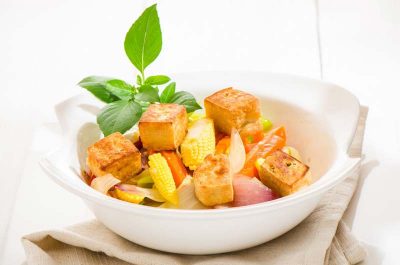
Research Shows That a Healthy Diet Will Slow or Stop Most Cancers
I am not a Doctor and have no desire to be one. My work is based on educating and specifically teaching prevention in our many workshops and programmes.
However, I am currently seeing seven clients for health counselling. They have terminal cancer, from prostate, ovarian, brain, and breast. All of them asked their doctor or oncologist about diet and each and every one of these clients received the same answer. Diet makes no difference!!! Eat everything in moderation.
While there have been some small improvements in survival rates over the past 40 years for cancer patients, the incidents of cancer continue to grow. This is regardless of the good intentions of their doctors aggressively attacking their tumours with surgery, radiation, and/or chemotherapy. Improved survival from a healthy low-fat, plant-based diet has been shown to positively affect survival in many cancers. Wouldn’t it make sense then if we focused on the importance of food and especially think about the big issue here – what we ingest daily creates health or disease.
What we eat is after all what makes our blood, tissue, organs and ultimately US. This enlightened dietary approach focuses on strengthening the human body and its magnificent abilities to heal and stay healthy; while, at the same time, removing cancer-causing and promoting elements from peoples diets. Human nutrition is no different from the soil that our food is grown in, what we eat feeds the gut biome. Make some of my fermented pickles to strengthen your overall immunity.
One of my clients who has an inoperable brain tumour had chemotherapy that did not help him. He has had remarkable results with the brain tumour shrinking by 50% since he started on a Macrobiotic diet and lifestyle. The second tumour is now also shrinking. Spontaneous regression happens so often when the body is given the right tools to heal itself.
There are no other ground-breaking answers on the horizon; we all need to look at our diet and lifestyle. People are becoming more educated and aware of their options outwith medical treatment and I am delighted to see this happen. My friend Professor T. Colin Campbell and many other Doctors in the States are doing incredible work with their educational programmes on prevention.

My recent response last week from the Government was the usual nonsensical approach. They never address my actual questions, they simply skip over them and reply to me with the same old same old. They should be committed to helping people find the path to health instead of focusing on funding the NHS (which is basically what all their current political campaigns are about.) Find your way back to your kitchen and enjoy cooking delicious, nutritious food for yourself and your family.
Baked Tofu with Baby Corn and Vegetables
1 pack block extra firm tofu
Marinade:
1 tbsp balsamic vinegar
1 tbsp toasted sesame oil
1 tbsp Shoyu
1 tsp brown rice syrup
1 tbsp minced fresh ginger
1 tbsp minced fresh garlic
½ tsp ground coriander
Place all these ingredients in a jar, close the lid and shake well to mix.
Press excess liquid from the tofu, cut into cubes and place in a container with a lid. Pour the marinade over, cover and place in the fridge for one hour. Preheat the oven to 180/375deg. Drain off the excess marinade and bake the tofu on a parchment paper lined baking sheet for 30 minutes. Turn the tofu for even baking halfway through. If you prefer a crusty finish, simply grill for a few minutes after baking.
Choose your choice of vegetables – I steamed some red onion, baby corn, carrots and green cabbage. The balance of steaming and baking made a lovely combination. Serve with rice or noodles.
In good heath
Animal Protein V Vegetable Protein

Last month I had two separate very interesting consultations with clients. Both had contacted me regarding the confusion that abounds regarding animal versus vegetable protein.
These lads are pounding their bodies at the gym 5 times a week and eating animal protein 3 times a day. Yikes!!! Apart from being ‘bulked up’ they don’t look healthy and both of them had skin and digestive problems along with a host of other health issues.
Reading their consultation forms about why they are eating so much ANIMAL PROTEIN inspired me to share with you all what nonsense the media continue to write about strength and muscle mass only coming from eating animals.
So, this is a message to all those out there who think that you need animal products to be fit and strong. The world’s largest and strongest animals eat plants. Many of my friends who are athletes were vegetarian for a long time but almost two years after becoming vegan they say they are stronger than ever before and are still improving day by day.
Don’t listen to those self proclaimed nutrition gurus and the food and supplement industry trying to tell you that you need meat, eggs, fish and dairy to get enough protein, it’s complete nonsense.
There are plenty of plant-based protein sources to choose from. I have created literally thousands of delicious dishes all high in protein and have taught hundreds of families to shift from an animal based diet, usually because of ill health, but nonetheless they have never looked back. Your body is going to thank you for switching from an animal based diet loaded with dead-food to a whole food plant based lifestyle loaded with micronutrient density. Go vegan and feel the power!
http://www.youtube.com/embed/ZT06I7BGcLw?rel=0 Visit Patrik Baboumian site, the vegan strongman who holds the world log lift record. There are also a host of other amazing vegan athletes around the world and I am delighted to be featured alongside them on many interviews.
As a graduate in Plant Based Nutrition from T. Colin Campbell Centre for Nutrition Studies I incorporate my certification from this fantastic course into my Macrobiotic Counselling sessions to empower and share even more information with my clients that the primary difference between animal and plant proteins is their amino acid profiles and it is those profiles that direct the rates at which the absorbed amino acids are put to use within the body.
Animal based proteins, of course, are much more similar to our proteins, thus are used more readily and rapidly than plant proteins. That is, ‘substrate’ amino acids derived from animal based proteins are more readily available for our own protein synthesizing reactions which allows them to operate at full tilt. Plant proteins are somewhat compromised by their limitation of one or more amino acids. When we restore the relatively deficient amino acid in a plant protein, we get a response rate equivalent to animal proteins.
Animal proteins also have a higher concentration of sulphur containing amino acids that get metabolized to acid-generating metabolites. As a result, a slightly lower physiological pH must be corrected and buffers like calcium are used to attenuate these adverse acid effects–to the disadvantage of the host. When I explained this to my clients they both had an Ah…ha… moment and were in agreement that their ‘arthritic’ problems were being caused by their high protein diet.
This recipe below for my mini shepherd’s pies is so easy and tastes delicious, plus it is packed full of protein, so as you can see from above there is no need to use animal protein. Cook up larger batches and freeze. The cooking classes I had with the boys worked well and as both are single and cooking for one they loved my approach to cooking and freezing. They now have breakfast, lunch and dinner handled and all with WHOLEFOOD PLANT BASED ingredients.
On my website and social media sites you will find a host of delicious alternative recipes to meat, dairy and eggs. These lentil burgers here pictured above are made quickly by using the Clearspring Bio Kitchen range which is their premium range of organic and biodynamic staple foods in clear glass jars which are naturally sweet and full of flavour.
Marlene’s Macro Mini Shepherds Pie
4-5 sweet potatoes, peeled and cubed
1 large red onion, chopped
2 cloves garlic, crushed
2 cups carrots, diced
2 cups organic sweetcorn
2 cups finely chopped asparagus
4 cups boiling water
2 sachets miso bouillon paste
2 cups red lentils
1 tsp. each of thyme, marjoram, oregano, basil
1 tsp black pepper (optional)
Tamari
1 tbsp. paprika
1 tbsp. dried parsley
Preheat oven to 175/350°. Boil sweet potatoes, until soft, drain and transfer to a large bowl, mash with a fork. Stir the paprika and parsley into the mashed potatoes and set aside.
In a heavy based pot, sauté the onion, garlic and carrots along with the corn and asparagus in a little water until tender. Set aside. Using a measuring jug, dissolve the miso bouillon sachets into the boiling water. Add the bouillon stock and the lentils to a heavy based pan. Bring to a boil then simmer covered until soft, about 20 minutes. Stir in the corn, asparagus, carrots, onions, thyme, marjoram, oregano, basil, and black pepper. Add some tamari (to taste) and mix well. If the mixture is too wet, add in some of the sweet potato mash to thicken.
Fill the bottom of a large casserole dish or small individual pie dishes with the lentil and vegetable mixture and top with the mashed sweet potatoes. Place on a baking tray to catch any overspill. Cook for 25-30 minutes.
In good health

Can What You Eat Improve Your Relationship

When two people are attracted to each other we often say that they have “good chemistry”. What if that’s really true? What we think is a clever metaphor may actually be the case. There is a great case to be made that our basic body chemistry influences our attraction to others and that this “chemical attraction” is a helpful tool in creating healthy relationships. It has long been observed that families that eat together generally have a stronger bond but what is the mechanism of this bonding?
In my teachings the first thing I express to all my clients and students is as follows:
Food makes the blood
Blood makes the cells
Cells make the tissue
Tissue makes the organs
And here we be!
Our body is being physically regenerated every day. In 21 days 50% of your red blood cells are renewed. Every four months, you have a fresh army of red blood cells. Over 90% of your body’s cells undergoes renewal on a regular basis. Even parts of the peripheral nervous system regenerate. It is our blood that delivers the basic material for our restructuring and as we all know it is our food that supplies the nutrients for this process.
Can similar food consumption spark a sense of closeness and trust between love interests, friends or colleagues? I believe so. There are countless strategies as to what makes a relationship work, but physical health is often overlooked. Researchers have discovered there are profound influences on our moods according to the foods we eat. Important nutrients such as neurotransmitters can tilt us toward a positive or negative way of seeing the world. Our nutrition also affects our senses.
My Love Of Teaching Traditional Chinese Medicine
In Traditional Chinese medicine the connection between the senses and our health is clearly described. Since intimacy often relates to sensory and emotional pleasure our sense of “oneness” with our partners is clearly related to the pleasure or agreeableness of their presence. This does not even address the issue of our pheromones, those chemical substances that we all excrete, are unconsciously detected, yet play a part in the attractiveness of another person. These hormones are dependent on our nutrition, as are all the hormones in the body. The bottom line is that healthier people tend to have healthier relationships.
Avoiding Food Fights
Sometimes, different food preferences and habits can be a source of stress in a relationship. To help build intimacy and trust, talk to your partner about issues surrounding your relationship with food. Sources of potential conflicts include:
- tension between a vegan and a meat eater
- tension between a picky and adventurous eater
- If either of you have a history of eating disorders or chronic dieting, that can also influence your relationships with food and each other
As with any relationship issue the first line of resolution is communication. It is important to understand where the middle ground is. We have found that in our health counselling that when partners are willing to try the plant-based diets we recommend (usually a three-week programme) they usually make the switch themselves. This shift is simply because of the improvement in health and not a “conversion” to a new way of thinking.
Eating together for Intimacy
- Blood chemistry has the strongest effect on sensitivities, so eating the same quality of food creates more harmonious sensitivities
- In some sense, your brain is the most important sex organ. Sex begins with affection, intimacy, and desire. Mealtime is a great time to unwind with your partner and build intimacy in a relaxed and pleasurable setting. If there is already conflict there with the different foods being eaten, tension is imminent.
I see many couples for health counselling who have this issue that threatens to end their marriage/relationship or friendship. Ultimately one of them is a meat eater and the other is like myself, a vegan. 80% of the time it is the man who is the meat eater. The woman is the one, who in a sense, is the driver of the shopping cart and the cooking in the home.
However, many men are now taking responsibility and joining my ‘men’s cooking classes, which is a joy to behold and music to my ears. I have so much fun with these workshops. At the last cooking class, they invite their respective partners to dine with us. It seriously is one of the most energized events I created. The partners cannot believe how their cooking skills have developed over the four sessions and are in awe when they are served their meal.
So, my advice to any who are struggling with their relationship would be to start at the very source of who we are and remind you all that food makes the blood and the chemistry of each living together should be in harmony. Happiness and joy will flow for sure. Please Go Vegan and love all of life, human and nonhuman alike.
In good health,
Tarragon Scented Parsnip Soup
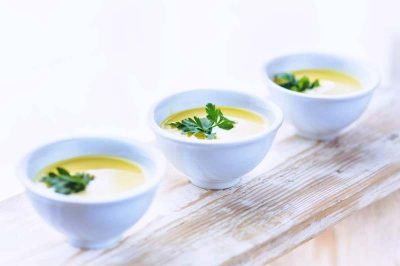
Parsnips resemble carrots and can be used in similar ways, but they have a sweeter taste, especially when cooked. The parsnip is rich in vitamins and minerals and is particularly rich in potassium. Several of the B-group vitamins are present and since most of the vitamins and minerals are found close to the skin, many will be lost unless the root is finely peeled or cooked whole. During frosty weather, part of the starch is converted to sugar and the root tastes sweeter.
Ingredients
- 1 large onion diced
- 1 leek diced
- 6-8 parsnips peeled and diced
- 3 cups almond milk
- 3 cups organic vegetable stock
- 4 tbsp. rice mirin
- 1 tbsp. dried tarragon
- 2 tbsp. sweet white miso
Instructions
Place the onions, leeks and parsnips in a soup pot. Add the almond milk, stock rice mirin and tarragon. Cover and bring to a boil. Simmer until the parsnips are soft (about 30 minutes). Remove a small amount of broth and dissolve the miso and return to the pan.
Transfer to a blender and blend to a cream or blend using a hand-held blender. Garnish with some fresh coriander.
Kidney Bean & Vegetable Soup
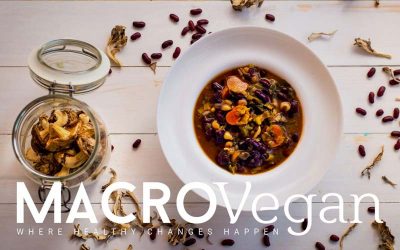
Both dried and canned kidney beans are available throughout the year. True to their name, these popular beans are kidney shaped and are especially good in simmered dishes where they absorb the flavours of seasonings and the other foods with which they are cooked
Ingredients
- ¼ cup dried maitake or shitake mushrooms (soaked in 1 cup water 15 minutes)
- 1 x 3inch piece of kombu seaweed (soaked along with the mushrooms)
- 2 tbsp. water or vegetable stock
- 2 cloves garlic crushed
- 2 small leeks very thinly sliced
- 1 tsp. Italian seasoning
- ¼ cup tomato passata
- 1 large carrot
- 1 large stalk celery
- 2 cups cooked kidney beans
- 1 sachet miso bouillon stock or vegetable stock cube in 3 cups of hot water
Instructions
Bring the kettle to a boil and add the ingredients for the miso bouillon or stock cube into a measuring jug and set aside. In a pot, warm the 2 tbsp water or stock and add the garlic and leeks and the Italian seasoning. Let sweat for five minutes. Add the tomato passata and cook for another 5 minutes. Stir in the carrot, celery, kidney beans, reconstituted mushrooms and kombu seaweed with the soaking water and the stock. Bring to a boil then reduce to low simmer for 25 minutes. Remove the kombu. Take two cups of the soup and blend to a cream and then add back to the pot.
Note: If using shitakes, after soaking, slice and discard the stem.
Butternut Squash Pear Bisque
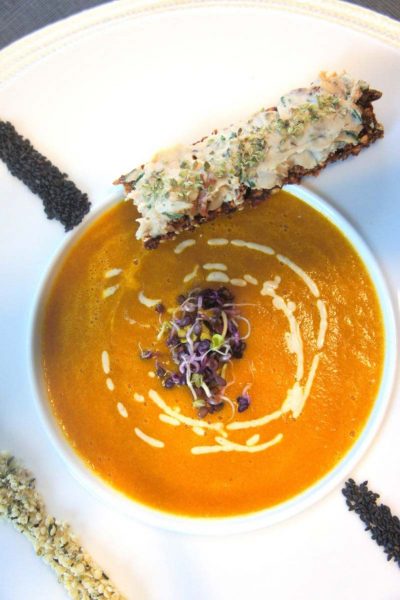
This sweet soup is so delicious made with a combination of fresh organic vegetables, fresh pears and coconut milk. An absolute treat and loved by all my clients and students.
Ingredients
- ¼ cup filtered water
- 2 medium leeks, white and tender green parts finely chopped
- 1 small butternut squash peeled and cut into 1-inch pieces
- 3 pears, peeled, cored, and cut into 1-inch pieces
- 5 cups miso bouillon stock
- Pinch sea salt
- 1 14-oz. can organic coconut milk
- (reserve 2 tbsp. for garnish)
- 1 tsp. chopped fresh thyme
- Fresh sprouts and coconut milk for garnish
Instructions
Make the stock by adding the miso bouillon sachet to five cups of hot water, set aside. Heat the ¼ cup filtered water in a soup pot over medium-low heat. Add leeks, and cook 10 minutes, or until soft, stirring often. Add squash and pears, and sauté 5 minutes. Stir in the bouillon and bring to a boil. Reduce heat to medium-low, and add salt, if desired.
Simmer 20 minutes, or until squash is fork-tender. Remove from heat and stir in coconut milk. Purée the soup in a blender or food processer, blend until smooth. Return soup to saucepan and stir in thyme. Reheat over medium-low heat 2 to 3 minutes, or until warmed through. Serve garnished with the fresh sprouts and coconut milk.





